About this Blog: Zanskar Valley is said to be one of the most remote destinations in India. Not much is known about this place. This travel blog is about our trip to Zanskar Valley and our experience of the place and its people; and not about travel information. We have a separate blog for planning your Zanskar Trip. So read on to know about how we spent our days in Zanskar Valley. I assure you will not find it boring!
Travelling to Zanskar Valley was an eye opener in many ways. It was not for the first time we visited the Zanskar (we had a glimpse of winter Zanskar when we had done the Chadar Trek way back in 2015). But this time we explored this remote valley, stayed at the remote villages and simply got awestruck by the simple, yet elegant monasteries. It was indeed one of our best travelling experiences.
Zanskar Valley is quite remote. We have done our fair share of travelling to remote areas, but nothing beats that of Zanskar. We had done the Chadar Trek to experience trekking in the trans-Himalayan region. But the people of Zanskar trek over the frozen River during the winter months just to connect to the outer world. Because, during the winters Zanskar Valley is literally cut off from the rest of the world due to snow.

It was during that time we had decided that we would visit Zanskar Valley during the “summers”, as quoted by one of our Zanskari guides. For them, Zanskar Valley has two seasons – the summer (when there is no snow) and the winters (when there is only snow).
So here is our experience of travelling to Zanskar when there was no snow. After a couple of cancelled trips, we finally reached Zanskar, the land of White Copper.
Zanskar Valley – The Land of White Copper
The origin of the name “Zanskar” is probably due to the natural occurrence of copper in the region. The name is derived from the Tibetan word “Zangs” meaning copper. There are, however, a few thoughts about the origin of the name – “Zangs-dkar” (white copper), “Zangs-mkhar” (copper palace), or “Zangs-skar” (copper star). Some are also of the opinion that the name is derived from zan meaning copper and skar meaning valley.

Zanskar once used to be a part of the Tibetan Kingdom of Guge, probably after the 10th century AD. The Kingdom of Guge included a part of Western Tibet along with Ladakh, Spiti and Zanskar. The kingdom was later divided into several separate kingdoms and once Zanskar and Spiti was part of one such smaller kingdom. The kingdom of Zanskar was later split into Padum, Zangla and Kishtwar. The landlocked Zanskar region existed as a peaceful Buddhist kingdom.
Later, Zanskar came under the influence of the Ladakhi kings. The peace-loving Buddhist people of Zanskar were time and again invaded by the Kashmiris, Lahaulis, Dogras and others.

Present day, Zanskar is a part of Kargil district of Ladakh. However, in recent days, the people of Zanskar have demanded to be in a new district altogether. It does make sense, because both geographically and culturally, Zanskar is quite separated from Kargil.
And all these facts were narrated to us by Tashi, the driver who had also become our friend during our 10 days long Zanskar Valley trip.
Zanskar Valley Trip
Hidden land, one of the most remote places, adventurous – we had heard about all these things before travelling to Zanskar Valley. We also heard and read about the precipitous peaks, the frozen rivers (of course during the winter season), plunging gorges and a host of other superlatives. But very few told us about the people of Zanskar – how warm they were, how happy and lively they were. Of course, we have heard about their kindness and fortitude; and had witnessed it firsthand as well.

We had met Tashi for the first time in Leh from where we had started our journey to the Zanskar Valley. From that moment, we had met several other people till we reached Kargil. And believe me, each of them was unforgettable in their own way.
It was completely overwhelming that almost the entire village of Tsazar had come to meet us the day before we were leaving Zanskar. Or the family at Lingshed who opened up their home for us for the night when we reached there in the evening. It is rare that you get so much love from people. And we experienced that. Zanskar Valley is thus a very special place.

Thus, in this blog, we are going to tell you about the people of Zanskar Valley. As we describe our journey through Zanskar valley, we will also tell you about the people we met and the friends we made in this remote land of white copper!
Day 1: Leh to Lamayuru – The Journey Begins

We reached Leh, met Tashi by whose car we were travelling across Zanskar. There are local buses from Leh to Zanskar that go through Kargil. But we had decided to travel through the new road that starts from Wanla and goes through the Singge La Pass. It was the ultimate off-roading experience we had in a long time.
We started from Leh and reached Lamayuru by late afternoon. We were staying at Lamayuru that night and would be starting for Padum the next morning.
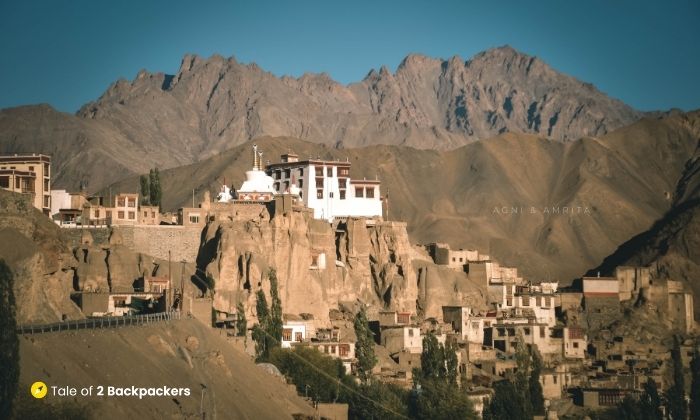
While everything was pretty fine, catastrophe struck in the late evening. We were charging our gadgets when there was some short circuit. Our camera charger and my phone charger were no longer working. Well, it was a catastrophe. It was the first day of the trip and our camera and mobile charger were as good as gone! Photographers there can understand what we were feeling at that time.
We finally went to Tashi to find a solution for our charger problem. And he promised to help!
Day 2: Lamayuru to Lingshed – The Epic Off-roading Journey

We were supposed to start early the next day. But our charger problem loomed and it was almost 11 AM when Tashi suggested we start towards Padum. He had spoken to his friend in Leh Market and he will send a camera and mobile charger to Padum through a car that would travel to Padum the next day.

It was midday when we started for Padum. The journey was not something we anticipated. For the first few kilometres, the roads were buttery smooth. But after that the real journey began. The views were simply mesmerising. At some parts we felt as if we were driving through the gorges, while at other parts the terrain became rugged and rough.

We crossed Sir Sir La Pass at an altitude of 4565 metres and reached Photoksar village by 2 PM. We had our Maggi lunch at a Maggi joint there. Photoksar village is quite pretty located at the base of the hills. After taking a few photographs of the village, we started our journey again.

Soon we crossed Singe La Pass (5100 m), the highest pass in this road. Well, when we had travelled, Google Maps had not reached this point. No roads were shown from Singe La to Padum.

At Singe La, we met a few engineers who were there to do a study of the roads. Driving past Singe La, we reached Lingshed Monastery. It was already 4.30 when we reached the monastery.
Lingshed – An Impromptu Stay
Lingshed Monastery is quite gorgeous. Perched on the hills at various levels, the entire monument looks magnificent. By the time we explored Lingshed Monastery, it was 5.30 PM in the evening and was starting to get dark.

And so, both Agni and I started wondering if it is safe to travel these roads at night. Tashi assured us that he would take us to Padum that day itself, but it will be almost 10-11 PM until we reach Padum. So we discussed, thought of the pros and cons of travelling that day. It turned out that all 3 of us thought it was prudent to stay at Lingshed that night.
Well, Lingshed is not a so-called tourist destination. There are no homestays there and definitely no hotels. There are a few guest rooms at Lingshed Monastery, but those were not taking any guests. Tashi went out to look for our stay. He came back after some time with a smile on his face and a night stay for us.
Staying at a Zanskari House
So we started walking down the hilly slope in the dark towards Lingshed village. I could not see a thing and with the huge backpack on my back, I literally had no idea where I was going. Later, the next day, we actually realised how downhill we had trekked in the dark. Sometimes, darkness does help.
A villager from Lingshed opened up his house for us to stay at night. We enjoyed their hospitality, had dinner of momos and drank butter tea before going off to sleep.

Did I tell you that this house is a traditional Zanskari house? The house had an open courtyard in the middle from where we could see the clear sky. The toilet was outside the house a little away. Ladakhi toilets are usually located at an elevation from the ground and one has to use ladders to reach the toilet.
After a good night’s rest, we were up again fresh and full of energy. We thanked our hosts and then started trekking up to the place where the car was kept. It was then we realised what distance we had covered last night!
Day 3: Lingshed to Zanskar Valley – The Final Journey

We finally started from Lingshed towards Zanskar valley. On the way, we had to cross the Lingshed River. The journey after this was quite an adventure. Roads were non-existent in some parts, while in others it was quite rough. But definitely, it was the thrill of the unknown that had us all charged up.
After traversing these dangerous roads for some time, we finally reached a stretch of good roads. We were reaching Zangla. And Tashi promptly informed us that we are entering the realms of Padum.
Zangla – Exploring the Ancient Palace

Zangla was one of the ancient capitals of the Zanskar Kingdom. Quite naturally, it boasts of a hauntingly beautiful palace – the Zangla Palace. The palace is located on top of a hill and there are a few chortens on the way up. Everything looked surreal. We were the only people there. Infact, I should mention that on the entire road from Lindshed to Padum, we encountered only a few vehicles. It was as if we owned the place.
Quite interestingly, Zangla Palace is the place where the famous Hungarian scholar Alexander Csoma de Koros had stayed for a considerable amount of time. Csoma had stayed in different parts of Ladakh and mastered the Tibetan language. It is believed that he had compiled the first Tibetan to English dictionary right here at Zangla.

However, De Koros has a connection to another of our favourite places, Darjeeling. We saw the tomb of Alexander Csoma de Koros at Darjeeling Cemetery.
The Zangla Nunnery is located just opposite to the Palace. After our visit to the Palace, we went to the Zangla Nunnery. We met several little monks here and had tea at a nun’s quarter.

After our visit to Zangla, we started towards our destination, Tsazar. Actually, we chose to stay at Tsazar, one of the villages of the Zanskar Valley instead of Padum.
Stongdey Monastery – Lunch with the Monks
On our way to Tsazar, we stopped at Stongdey Monastery. This monastery was also located on a hilltop and looked quite breathtaking from a distance. Well, we had a surprise for us here. We had arrived during lunch time and the monks there invited us for lunch.
It was a completely humbling experience to eat with the monks of the Stongdey Monastery. There are times when we feel so grateful for all the blessings in our lives. This was one such moment. It must have been the ambience or the gesture, but we were feeling so thankful and cared for.

The monk then invited us to his quarters where we spent some time and then in the late afternoon, we started for Tsazar.
Tsazar – Meeting Zanskar and its people
What can I say about Tsazar? It was the place that stole our hearts. We were staying at the house of Skalzan. Her house was also a typical Zanskari house. However, this time the toilet was inside the house itself!

Skalzan stays at Tsazar with her mother and youngest daughter. She lost her husband years back. Once again, these are not typical homestays as we know them to be. We were given the best room of the house, which happens to be the glass room.

Every house in Zanskar Valley has a room that has a wall made of glass. This is mainly for retaining the heat and warmth during the winters. In the evening, ladies from other houses in the village came to meet us. They all sat in the main room (comparable to our drawing rooms), cut vegetables and chatted.
They asked us all sorts of questions and we asked them about their lives in Zanskar valley. I also learnt how to make momos and Tibetan bread. Making momos might be cliched but I had such a fun time with these women. And Agni was literally smothered with a lot of affection! And yes! I also learnt how to make the yak milk butter tea. Though if you ask me to prepare it now, I will not be able to do it.
Butter tea is quite a common drink. It helps in retaining the warmth during the winters. Just like many other cuisines, butter tea is also an acquired taste. While Agni could drink it, it was a bit too strong for my taste. We stuck to our favourite black tea.

The main room had many pictures of the family. There was one picture of Skalzan and her friends in front of Gateway of India, Mumbai.
“Oh! I visited there long back. Before my marriage!” She laughingly told us. Her older daughter studies at Dharamshala. She has not been home for almost a year because of the Covid situation. Skalzan plans to take her younger one to Dharamshala to meet her older daughter if everything goes well.
Life was basic in Tsazar in Zanskar Valley, but it was one huge family where everyone had each other’s back. I guess that happens when people stay in such harsh conditions.
A day in the house of Zanskar Valley
I was happy I stayed at Tsazar and not at a hotel in Padum. Because I got to see and learn about the Zanskari lifestyle closely. Skalzan wakes up early in the morning to take the cattle out for grazing. She comes back and gets her daughter ready for school. In the meantime, aunty (Skalzan’s mother) who is almost 80 dries the grains in the sun.
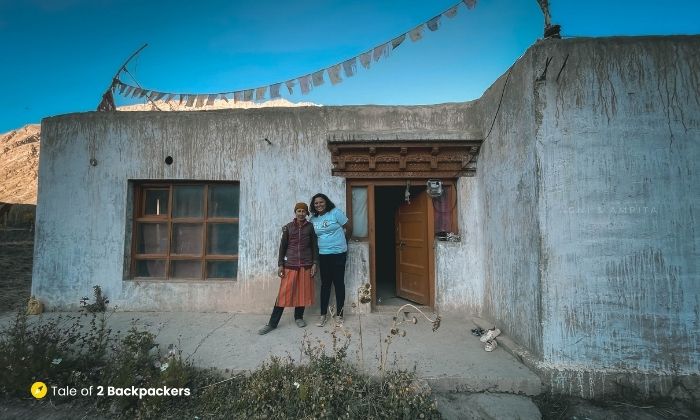
The daughter was in Standard 8 when we visited and her school is 10 km from Tsazar village. She usually walks to school if she does not get any lift to school on the road.
Many of the ladies go out to MGNREGA work in the morning. Yangchey, another beautiful lady we met goes out every morning at work walking for almost 8 to 10 km, works for the day and comes back home.
As I mentioned earlier, winters in Zanskar are harsh. The Zanskari household stores all the essentials for the winter. They store grains, vegetables, potatoes, onions, and oils for the winter. They also store husks and cattle fodder for the winter.

There is one water source in the village. The women go to the community tap to get water everyday in the morning and evening. Mobile connection was also quite choppy in the village. Only BSNL worked and recently the Jio network was also found. Internet connection was poor. Our Airtel Postpaid stopped working at Tsazar.
These people work hard all day long facing tough conditions that are not under their control. Yet they smile and not complain. And here I complain about all trivial things in life and these little girls and boys in the village walk for 10 km to reach school!

If Chadar Trek had me thinking about Zanskar and its people, this trip literally made me appreciate and respect them.
We were supposed to stay for 2 nights at Tsazar and the rest 2 nights at Padum. However, we ended up staying all the 4 nights at Tsazar. We loved the village and its people so much.
Oh! Did I mention that we received our camera and phone chargers on the day we were at Tsazar? We were just elated!
The simplicity of Tsazar

So far, I have been talking about the people of Tsazar. However, its natural beauty is also quite stunning. Tsazar is a small village located about 20 km from Padum town, having stretches of fields and a few houses scattered here and there. The Zanskar River flows just behind the village. The shepherds take their cattle for grazing near the river.

There is a small monastery in the village. Each village in Zanskar Valley has its own monastery. Religion is a huge part of life in Zanskar valley. Prayer wheels were found in all the villages. All the aged ones had prayer beads in their hands.

It is so peaceful at Tsazar. We spent hours sitting beside the riverside and near the fields. And definitely we spent lots of time talking to the people. That was one of our best experiences.
The beauty of Tsazar lies in its simplicity.
If Zanskar was perfect, then our stay at Tsazar definitely was the cherry on top.
Day 4: Exploring Zanskar Valley
While staying at Tsazar village, we explored Padum fully. One of the days, we visited the Stakrimo Gompa, Pibiting Monastery and the Five Dayani Buddha carvings.
Where we saw a Unique Buddhist Ceremony

It was at Stakrimo Gompa where we witnessed a rare ceremony in the monastery. Each monastery has a monk heading it for a few years. The transfer of this responsibility from one monk to the other takes place by an elaborate ceremony. That day we visited Stakrimo Gompa, one such ceremony was in progress.

It was going to be a long ceremony, but we stayed for some time there. Once again, they offered us butter tea and biscuits as we sat together with the lamas and the local people.
Day 5: Trek to Phugtal Monastery

The next day was quite exciting for us. For we were going to the Phugtal Monastery. Earlier, to reach Phugtal Monastery, one had to trek for 3-4 days and now it was only a matter of 2-3 hours. Roads have reached till Purne. We, however, drove till Cha village and started our trek from there.

After taking many photography breaks and a lunch break by the Tsarap River, by the time we reached the monastery, it was already 3 PM. We had decided to stay at Phugtal. There are two guest houses near the monastery, one run by the tourism department and the other run by the monastery. One of them was under repairs.

We got a room in the other guest house. But then, there was a catch there. It did not have a bathroom. Well, technically there was an attached bathroom, but that was used as a godown at that time. So, we had to use the common bathroom outside the property.
The room was basic, but it had a great view of the monastery. Basically, we could simply wake up in the morning and look at the Phugtal Monastery from the window!
Meeting the monks of Phugtal
This guest house was looked after by a few young monks. In the evening they had come down from their monastery quarters to cook for us and look after the guests. They were an interesting lot. One of them was quite shy and wouldn’t speak with us. He always had this intense look about him. Later we came to know, he generally oversees the weekly morning prayers held at Phugtal Monastery. But once he opened up, he was a delight to talk to. He would tell us about his travel stories to monasteries in Dharamshala, Ladakh and Karnataka. He was also quite tech savvy and told us about his YouTube Channel.

And then there was “the Amitabh Bachchan”. Well, he was another young monk, very loquacious and always keeping the others on their toes. He would mimic Amitabh Bachchan to the tee and so he was called so. He was also the head cook of the team. And we found it really hilarious seeing him shooting orders to the others. As much as he was lively and funny, he was extremely shy of the camera and would not let us take any of his photos and videos.
He cooked Dal-chawal for us for dinner. Believe me, it was one of the most satisfying meals we had in a long time.
The next morning, we went to Phugtal Monastery and witnessed the morning ceremony there.
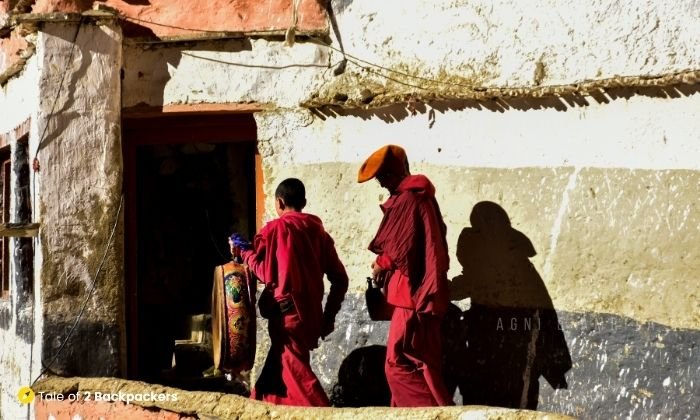

We met a few monks and asked them about the place. As usual, winters are quite harsh in Phugtal also. It snows and the entire region becomes a kingdom of white. The Tsarap River that flows by also becomes frozen. The monks hardly leave their quarters during that time. A few of the monks leave for various villages just before the winter sets in. They stay at the monasteries in those villages during the winter.

Day 6: Phugtal to Padum
We spent around 3 hours in the monastery and then started our trek back to Cha where our car was kept. Once again, we started our journey back towards Tsazar.
Day 7: Chilling at Padum

The next day we simply chilled. We spent a lot of time at Tsazar, visited Padum market and explored the area. Padum is the largest town in Zanskar valley. In reality, Padum is just a small town with most of the shops concentrated in the market area.
Having Samosas at Padum
And yes, we also found a North Indian restaurant that serves amazing samosas and tea in Padum market. If you happen to visit Zanskar Valley, you must have samosas from there. They also serve North Indian style rice and vegetables during the lunch hours.
Losing our Way in Dark

That day, Tashi invited us to his home for dinner. Tashi’s home is at Tsazar as well. Late evening, we took our torches and went out towards Tashi’s house. It was completely dark at that time. Tashi’s house is just a 3 minutes-walk from our stay. In the morning, you could actually see his house. But during the night and without any lights, we simply could not understand which way to go. We roamed around trying to find our way, but could not. What idiots, we were!
Since we could not find our way to Tashi’s place, we came back and asked Skalzan for help. She smiled and took us to Tashi’s place. We met his family and had a lovely time there. Well, while returning, we did not lose our way! Though there were chances that we might!
Day 8: Monasteries and More

It was our penultimate day at Zanskar Valley and we visited three other monasteries in the region. First we went to Sani village. It was a quaint village having the typical Zanskari huts.
The Sani Monastery is one of the oldest monasteries in the Ladakh and Zanskar region. Different parts of the monastery were built in different eras. That is perhaps true for many of the religious monuments in India. Sani Gompa is built in the form of a castle and has a huge Stupa inside the complex. The Stupa is known as the Kanishka Stupa and is believed to have been built during the times of Kanishka, the Kushan ruler of 2nd century CE.

There is also a lake in Sani village, known as the Sani Lake. There is a statue of Guru Padmasambhava in the middle of the lake and the lake is considered to be quite sacred among the villagers.
Dzongkhul Monastery & Looking for Umasi La

From Sani, we went towards another monastery – the Dzongkhul Monastery. Well, we had thought that Phugtal Monastery was the ultimate one; and that was before we saw Dzongkhul Gompa. This monastery had an entirely different charm to it. We had to drive through a winding road to reach the monastery. The views were nothing short of spectacular.
Well, I am running out of adjectives while describing Zanskar Valley. It happens to the best of us!
Agreed, that we did not have to trek to it or it is not as remote as Phugtal, but we found Dzongkhul monastery to be extremely galvanic. The monastery is nestled on a rock face overlooking the mountain ranges and the Dzongkhul falls. From there, we could see a glimpse of the Umasi La Pass – the pass that connects Zanskar Valley and Kishtwar in Kashmir.
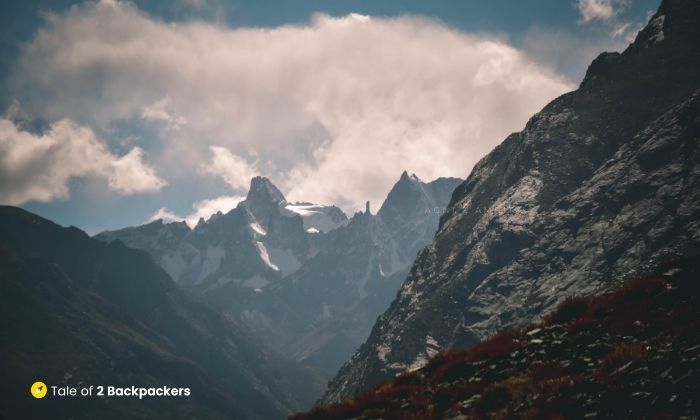
When we visited the monastery, there was only one monk residing there. He took us inside the monastery and the meditation room. Many Tibetan scholars and teachers have meditated in the caves of this monastery. And perhaps this was one of the reasons why this place felt so peaceful.
Largest Monastery of Zanskar Valley

Karsha Monastery is the largest monastery in Zanskar Valley. Located in Karsha village, it has the most number of villages under it. The monastery is perched on the hills and overlooks the valley and the river basin. By the time we reached Karsha, it was almost 4 PM.
At Karsha, we met a few little monks who had come for their classes. Well, there was less studying and more naughtiness. Those young monks were quite interested to see us and had all sorts of questions for us.

Karsha Monastery had a number of shrines and beautiful rock paintings. However, the most important feature of the monastery is a chorten that contains the mummified body of Rinchen Zangpo.
Dinner with the monks!
There is a huge kitchen as we just enter through the monastery gates. Food was being prepared in the kitchen for those naughty young monks. As we were leaving the gompa, we saw the young monks having a meal of khichdi. The monk who was serving simply asked us to join them.

Well, we were hungry, but also a bit hesitant to join the monks for food. The elderly monk saw through our hesitation. He simply smiled at us, went inside the kitchen and brought us two plates of Khichdi. A couple of young monks came to me, held my hands and made me sit with them to have the food. I wondered if it was a dream! It felt so surreal – we were having a very early dinner (it was almost 6 PM) with little monks and listening to their happy chatters. If you looked closely, you might have found my eyes glistening. And now, I am being so emotional!
We dined with the monks, cleaned dishes with them and then returned to Tsazar. Our penultimate day in Zanskar Valley could not have been any better.
Day 9: Tsazar (Padum) to Rangdum
It was the day to bid goodbye to Tsazar. By the time we were starting, many from the village came to bid us farewell. It was such an overwhelming feeling.
Goodbyes are not bad. It holds the promise of Returning.
Passes and Glaciers
We started from Tsazar in Zanskar Valley and crossed the Drang Drung Glacier, the second largest glacier in the country after Siachen glacier.
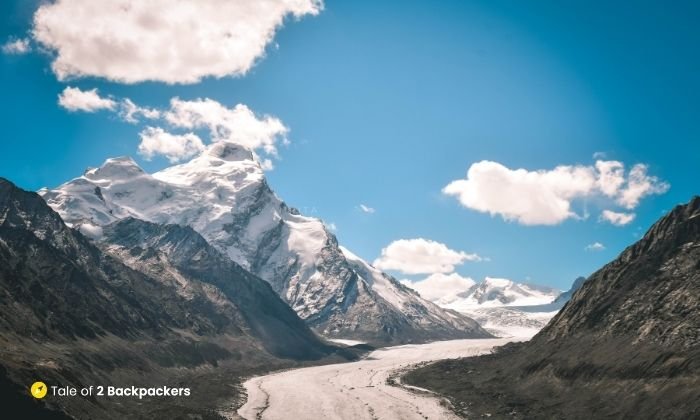
Next, we also crossed Penzi La Pass that connects Zanskar Valley and Suru Valley. We were almost at the end of Zanskar valley. We reached Rangdum by late afternoon and stayed at Rangdum Guest House. Here we met Skalzan’s brother, who was quite happy to meet us. He could not stop gushing about his sister. He was going to Kargil for work.
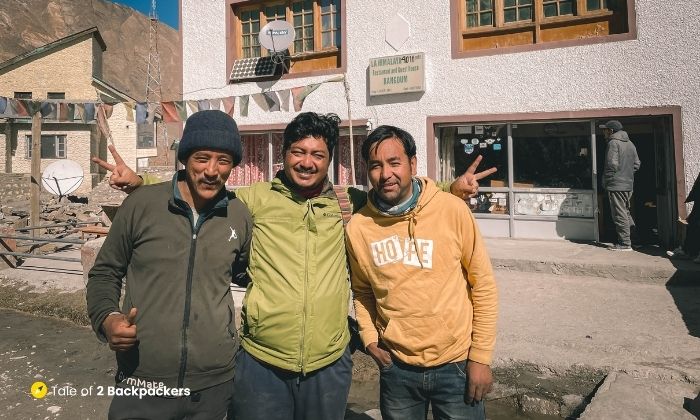
It was coldest at Rangdum. It was here where we found frozen water pipes and severe cold winds. We had an early dinner for us and a nice relaxing sleep before we started towards Kargil the next day.
Day 10: Entering Suru Valley

Suru Valley is just beautiful and different from Zanskar Valley. It was greener and lusher in contrast to the stark landscape of Zanskar Valley. We crossed the twin lakes, got a glimpse of the Nun-Kun peaks and finally reached Kargil. But we leave that for another tale.
Final Words

There are some places that simply take your breath away with its beauty and charm. And there are some places where we fall in love because of the people. Zanskar Valley falls in both the categories. We spent 10 days in Zanskar Valley and never for once felt we were away from home.
It was the adventure, the unexpectedness and the warmth of people that made this trip one of the most memorable. While we brought back great memories from Zanskar Valley, we also left a part of us there, a place we have fallen in love with irrevocably. Zanskar Valley was much more that we had expected!
A Few More Photographs from Zanskar







Pin it for a later read!







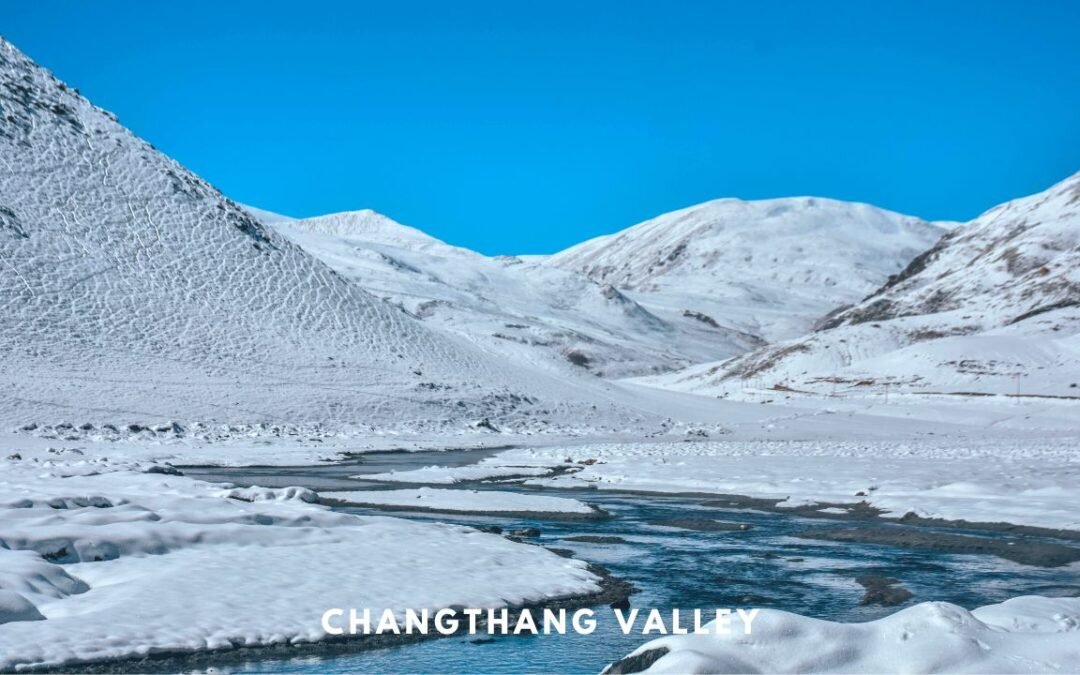



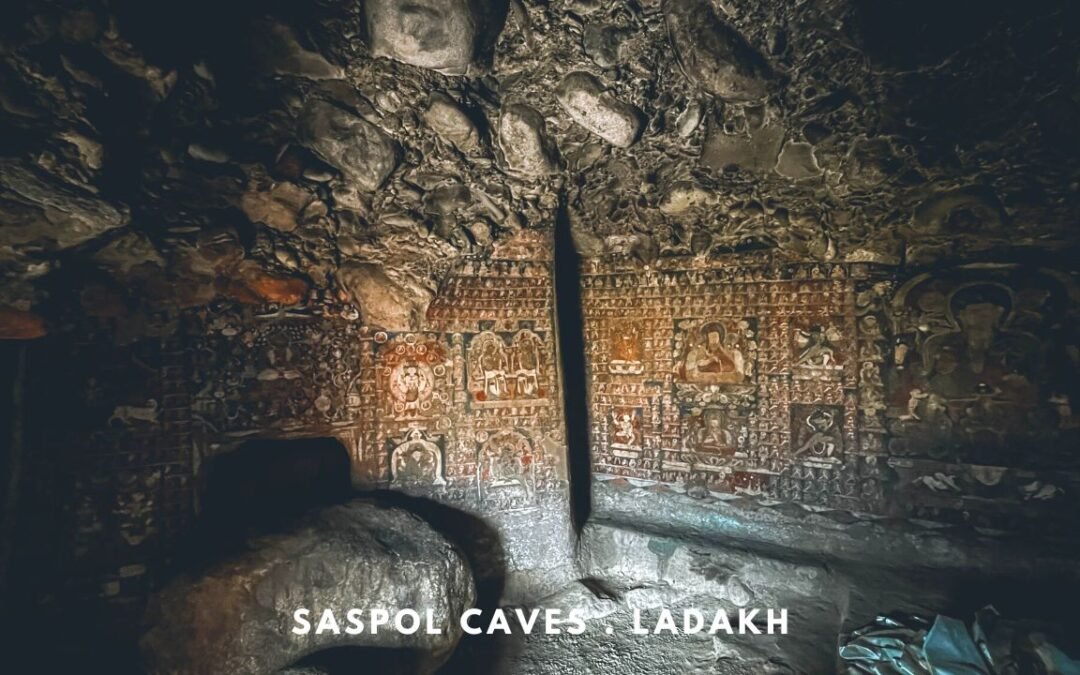

Even for a non-snow trip, this was damn good. Right from the never ending travel to reach this area, the phone charging incident, and the impromptu stay make this one of the best trip stories I have read in a while.
Truly, it was quite an experience! Thank you for the comment.
I didn’t know the meaning of Zanskar earlier. Thanks for describing. Neither was I aware of the history of the same. Your write up has made me curious and put this destination as part of my ‘To Visit’ list. Will soon make a paln to visit.
Yes, do visit Zanskar. It is an enchanting place.
First of all, again I loved this piece of article. Very informative and detailed with excellent photographs. Second, now I think I can visit Zanskar too and spend an amazing time there. Help me out with the cost part.
Thanks Pamela! Sure we would love to help!
I came to know about Zanskar valley through your post only, it’s so beautiful and mesmerising. I really wish I get to visit this place. In fact, I have shared this article with my friends also, they were also fascinated to see the beauty of this place through your post.
Thank you so much for your lovely comment!
What an epic trip this must have been. Needless to say, the views in Ladakh are simply out of this world. Lamayuru is a place that we fell in love with. Loved reading about your interactions with the people of Zanskar.
It was indeed an epic trip! Thanks for the comment.
Wow so many things to do in Zanskar Valley. I have visited it only once and have just scratched the surface. I think I will need to go back and spend more time there, especially trekking there.
Yes, Zanskar is quite untouched. I am sure you will love the place.
We read so much about Ladakh trips. Yet this post is a revelation. Zanskar is so tempting and sorry for Bangla – eechhe hochhay akhoni Cholay Jai!
Zanskar is indeed tempting! And… “Icche puron obosshoi hobe” 🙂
Just wanted to pop in and say thanks for this article!
Is Singe La pass different from Shingo la pass?
Yes, they are different. Shingo La is another name for the Shinku La Pass that is between Zanskar and Himachal. Singe La (also called Singge La) is the pass between Khaltse area and Padum.
Thank you a lot for sharing a beautiful inside view of Zanskar & its people. Planning to visit the same in mid August, 22 via Manali-Zispa-Padum and return via Kargil-Drass.
Good to know that you are planning a trip to Zanskar. And thank you for leaving a comment. Hope you have a great trip.
Hello
Loved the details and pics
Going zanskar on 19 june via manali shingu la and return via srinagar
Any tips plz regarding route and stay
Thanks on advance
Thats great! Hope you have a great trip!
The off reading, wonderful people, mesmerising views and the experience of adventure – your trip was memorable. Would like to make a trip to Zanskar as well, request you to help out
Thank you Himanshu! Zanskar is truly a memorable experience. Please send in your queries for Zanskar trip at info[@]taleof2backpackers[.]com
Very informative. Quite a good insight about Zanskar.
Commendable. Thank you.
Thank you!